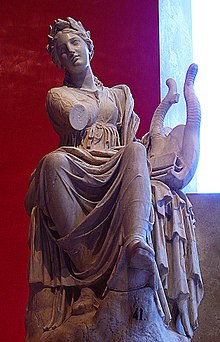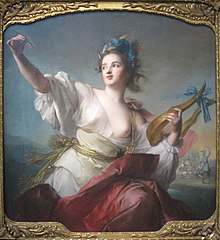Terpsichore
Appearance
This article needs additional citations for verification. (May 2016) |


In Greek mythology, Terpsichore (/tərpˈsɪkəriː/; Τερψιχόρη) "delight in dancing" was one of the nine Muses and goddess of dance and chorus.[1] She lends her name to the word "terpsichorean" which means "of or relating to dance". She is usually depicted sitting down, holding a lyre, accompanying the ballerinas' choirs with her music. Her name comes from the Greek words τέρπω ("delight") and χoρός ("dance"). She is also a Mother of the sirens and Parthenope.
In popular culture
Historical
- The British 32-gun frigate HMS Terpsichore (1785) commanded by Captain Bowen participated in the Battle of Santa Cruz de Tenerife (1797).
Places
- Terpsichore is also the name of a street in New Orleans' historic neighborhoods of Faubourg Lafayette and the Lower Garden District. It runs alongside Euterpe and Melpomene streets, also named for Greek muses.
- Terpsichorean is also the name of the Choreography Society of Hans Raj College, University of Delhi.
Literature
- Terpsichore figures among her sisters in Hesiod's Theogony.
- When The Histories of Herodotus were divided by later editors into nine books, each book was named after a Muse. Terpsichore was the name of the fifth book.
- The character of Wilkins Micawber, Esq, Jr. is described as a "votary of Terpsichore", in an Australian newspaper brought to London by Dan Peggotty in 1850 novel David Copperfield by Charles Dickens.
- T.S. Eliot in the poem Jellicle Cats from Old Possum's Book of Practical Cats (1939), refers to the "terpsichorean powers'" Jellicle Cats as they dance by the light of the Jellicle Moon.
- Terpischore "Choral Dance" is the name of a chapter in Theresa Cha's Dictee.
- "Some Terpsichore" is the title of a short story in a 2014 book, Thunderstruck and Other Stories, by Elizabeth McCracken.
- "The Chaos" is a poem where Terpsichore is mentioned in a line.
- Terpsichore is referenced in George Orwell's first novel "Burmese Days" in a dialogue by one of the minor characters, Mr Macgegror.
Music and dance
- "Terpsichore" is the title of a large collection of dance tunes collected by Michael Praetorius, some originating with Pierre-Francisque Caroubel and some later adapted for wind ensemble by Bob Margolis.
- Terpsichore is also found in François Couperin's "Second Ordre" from the Pièces de clavecin, and in the third version (HWV 8c) of Handel's opera Il pastor fido (1712). This opera is sometimes referred to as Terpsicore and Il pastor fido.
- The Jimmy Van Heusen/Sammy Cahn song "Come Dance with Me" (popularized by Frank Sinatra) includes the lyric "what an evening for some Terpsichore." However it is sung as a three-syllable word with the "chore" component pronounced like "core" (to rhyme with "for") rather than "curry".
- The Russian singer Origa sings a song, "Tersicore".
- Canadian punk band Gob has a song called "Terpsichore" on their album Apt. 13.
- The eighteenth century French dancer and courtesan Marie-Madeleine Guimard named the private theater in her private palace (1766) the Temple of Terpsichore.
- Terpsichore in Sneakers is the title of a 1980 study of postmodern dance by dance historian and critic Sally Banes.
- The song "Terpsichora" is included on J-Pop singer Akiko Shikata's 2007 album Istoria: Musa.
- The album Cool by Bob James and Earl Klugh features a track called "Terpsichore".
- In the art of the Russian rockband "Splean" is the eponymous song
Media
- In the 1936 feature film Swing Time starring Fred Astaire and Ginger Rogers, Lucky (Astaire), when asked by Mr. Gordon, why he wishes to learn to dance, answers: "To flirt with terpsichory". He then proceeds to take a dance lesson with Penny (Rogers), culminating in a paired tap routine.
- In the 1947 film Down To Earth, Rita Hayworth plays Terpsichore, who is annoyed and visits Earth to change a musical that depicts her in a bad light.[2]
- In the 1948 Musical Comedy film "April Showers", starring Jack Carson and Ann Sothern, Carson plays a Victorian Era vaudevillian. While performing an act with his son, Buster (played by Robert Ellis ), Buster asks "Shall we dance Mr. Lovejoy?", Carson replies by saying "Terpsichore Mr. Gay!"
- In the 1969 Western film McLintock!, Drago (Chill Wills) introduces an exhibition of new dance steps as Terpsichorean.
- Olivia Newton-John plays the muse Terpsichore as Kira in the 1980 film Xanadu.[3]
- Terpsichore is featured as a character in the 1997 Disney animated film Hercules.
- In the 1961 Gunsmoke episode "Old Yellow Boots", Doc (Milburn Stone) boasts to Chester (Dennis Weaver) that in his younger days he was known as "the terror of Terpsichore".
- In an episode called "Quick-Quick Slow Death" of the UK crime agent series The Avengers, a dance institute is called Terpsichorean Training Techniques Inc.
- The Terpsichorean Muse is referred to by John Cleese in the Cheese Shop sketch of Monty Python's Flying Circus.
- The fifth season episode of Xena: Warrior Princess, "Lyre, Lyre, Hearts on Fire", centers around a battle of the bands for Terpsichore's Lyre.
- Terpsichore is a technique used by the royal guard Neferpitou to "dance past one's limits" in the manga Hunter × Hunter.
- In the Les Luthiers' Unen canto con humor comedy show is referred in a sketch by Daniel Rabinovich and Marcos Mundstock, but Daniel improperly pronounces her name, calling her "Esther Píscore".
- Terpsichore is one of the legendary "Mythic Weapons" obtainable in Final Fantasy XI, only equipped by the Dancer class.
- The Onyx Terpsichore is a weapon of the Hunting Horn class in 2115's Monster Hunter 4 Ultimate for Nintendo 3DS.
- In an episode from 1966 called "Space Circus" of the US science fiction series Lost In Space the character of Dr. Zachary Smith, whilst preparing to rehearse for an audition with an alien circus troupe, refers to his intention to make use of the "art of terpsichore" after deciding to let the character of the robot sing instead of him, thus leaving him free to concentrate purely on dancing.
- Terpsichore is also a character in the book, and the movie adapted from said book, Shrek 3. In said book/movie combo, Terpsichore is portrayed as a fair maiden who holds a burning flame of wild passion and affection for one of the main characters - better known under the name of Donkey. The wife of Donkey, alas the villain of the first movie (the Dragon) is immediately overwhelmed by the ferocity of her own flaming jealousy, as she is almost ridiculously possessive of her husband, who is also the father of her children (dragon-donkey hybrids). Or maybe this all just happened inside of an alternative reality. (see: Mandela Effect)
See also
- Muse
- Muses in popular culture
- The asteroid 81 Terpsichore
References
- ^ Theoi Project, Greek Mythology, Muses [1], Retrieved April 29, 2014
- ^ "New Flower Named For Rita Hayworth". Pittsburgh Post-Gazette. Pittsburgh, Pennsylvania. August 29, 1946. p. 15. Retrieved May 2, 2016.
- ^ Ross, Robert Alan (August 23, 1980). "'Xandau' is a pale imitation of old musicals". St. Petersburg Times. St. Petersburg, Florida. p. 5B. Retrieved May 2, 2016.
External links
 Media related to Terpsichore at Wikimedia Commons
Media related to Terpsichore at Wikimedia Commons- Warburg Institute Iconographic Database (ca 40 images of Terpsichore)
